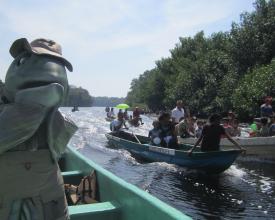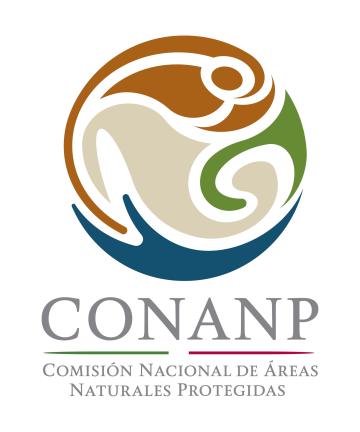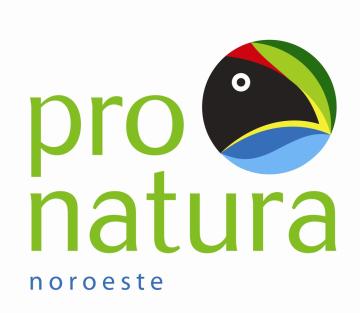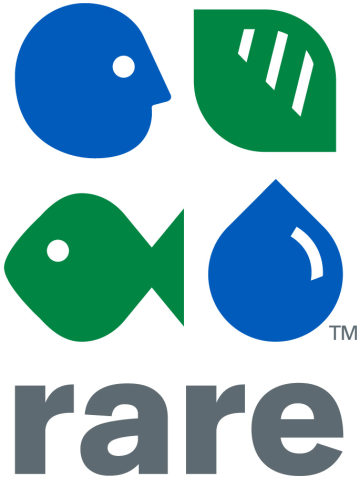
Community Stewardship of Marine Resources
Full Solution
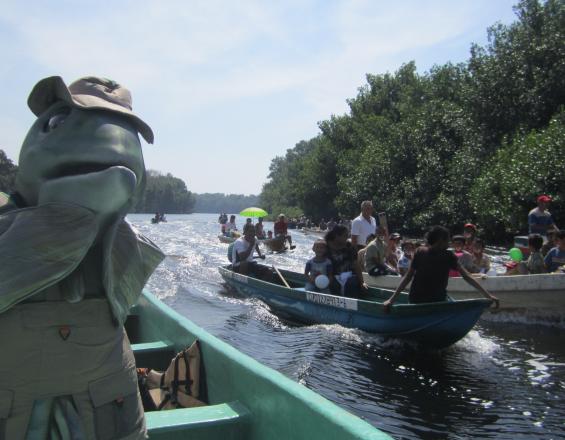
The mascot Robalin presides over the “Navigating for Responsible Fishing Festival"
Ramón Flores, CONANP
Pride conservation campaigns are implemented in four Latin American countries to generate community stewardship of marine resources, by adopting Fisheries Replenishment Zones (FRZ), alternative income activities and voluntary gear changes. Social marketing, fisheries technical assistance, capacity building and biological monitoring changed community behavior to reduce fishing threats and increase fish abundance, species diversity, and habitat health.
Last update: 02 Oct 2020
4252 Views
Context
Challenges addressed
overfishing, absence or limited compliance with Fisheries Replenishment Zones
• Overfishing
• Absence or limited compliance with Fisheries Replenishment Zones
• Unsustainable fishing practices
• Lack of buy-in, lack of ownership, of communities´ care for their resources
• Lack of fisher organized groups and unity
Location
Mexico
Central America
South America
North America
Process
Summary of the process
The training program is arguably one of the most important components of a Pride campaign because it sets fellows up for success, through strengthening their capacities and skills required for the other building blocks. Amongst these, the Theory of Change is the project’s framework that is used in Pride campaigns for strategic planning, ongoing decision making and evaluation. It represents a hypothesis of how the Pride campaign can help address critical conservation issues and is the foundation necessary to design reliable formative research. This research helps define realistic and measurable campaign objectives regarding audience’s knowledge, attitude, interpersonal communication and perceived barriers of a certain behavior change. These objectives are addressed through both social marketing as well as technical assistance activities that align with target audience characteristics and stages of behavior change. The impact of the campaign for these objectives as well as threat reduction and conservation goals are measured through the monitoring and evaluation component.
Building Blocks
Pride training program
Rare’s Pride Program training is a two-year process through which local conservation leaders receive formal university training, followed by periods of field-based formative research and results analyses. Participants learn how to change attitudes and behaviors, mobilize support for environmental protection, and reduce threats to natural resources. Rare’s local partners not only receive classroom training, but also implement an entire social marketing campaign in their communities, designed around a specific conservation goal. Participants in the program receive a toolkit for community outreach: Training 1 provides trainees with basic community engagement tools, so that they can start embedding themselves in the target audience and earn their trust. Training 2 takes place after a period of 1-2 months of field embedding, and teaches research techniques for qualitative and quantitative formative research. Training 3 takes place after 2-3 months of data collection and information gathering, to analyze data collected and design the Pride Campaign. Training 4 takes place upon campaign conclusion, to evaluate results and produce final report.
Enabling factors
• Partner commitment to secure full-time dedication of participating fellows to the Pride program.
• Continued full engagement and adequate progress of fellows during the entire duration of the program.
• A minimum of high school degree for program participants/fellows.
• A basic Pride curriculum, tailored to programmatic theme.
• Basic infrastructure as well as training team.
Lesson learned
A key element in the success of the Pride training program is to have specific deliverables and frequent evaluations of capacity. These deliverables and grades are recorded in an online tool that allows for multiple party follow-up. The same basic training assessment is delivered at the beginning of the cohort, and upon completion of every training phase. Having participants with different backgrounds and levels of academic training (high school or university degrees), presents both a challenge and an opportunity. The challenge is having to adapt lesson content and activities to accommodate for these differences. The opportunity is precisely to take advantage of these differences in skills and backgrounds to recruit participants to share past experiences and help fellow trainees in the learning process as mentors.
Resources
Social marketing (SM)
Social marketing (SM) uses commercial marketing methods and tools (e.g. diffusion of innovations, behavior-change-focused communication channels and messages, community mobilization) to promote a voluntary behavior change in a target audience, that benefits society as well as the target group. For a Pride campaign, social marketing is an integral component to promote community stewardship of their resources. Creating a clear, consistent and positive identity (i.e., a brand) around the conservation/management of their resources that resonates with community perceptions, values and traditions regarding these resources helps boost community buy in. This brand is linked to a clear request (e.g., what do you want your target audience to do when it comes to sustainable management of their resources), both of which will be underlined and repeated throughout campaign activities (e.g. community events, media outreach) and promotional materials (e.g., posters, booklets, flyers, wall paintings, props, text messages) that form part of the social marketing strategy.
Enabling factors
• Adequate size of target audience for (100+).
• Determining clear audience behavior changes that lead to conservation goals.
• Well designed, planned, executed and analyzed formative research that elucidate conditions of behavior changes.
Defining audience characteristics.
Clearly define how ready your audience is to adopt new behavior.
Tailor communication channels, activities and messages.
Involve audience and key stakeholders in design and implementation of marketing strategy increase ownership/stewardship
Willingness of implementing partner to adopt SM tools
Lesson learned
Campaigns that best follow these ‘steps’ (i.e. enabling factors), developed activities, messages and choose media channels that are relevant to their audience characteristics and stage of behavior change. These well-developed social marketing strategies have proven to accelerate the adoption of sustainable practices by the target audience, through creating community support, buy in of audience’s trusted sources and key influencers, as well as clear, focused and concise messaging through marketing materials and the media.
Resources
Monitoring and evaluation
Monitoring and evaluation (M&E) are vital components of every Pride campaign, without which assessment of the effectiveness of the intervention cannot be conducted. M&E takes place in every component of the Theory of Change (please refer to the building block 'Theory of Change' for a brief description of each component). Monitoring keeps score on how effectively capacities are built, how effectively social marketing efforts lead to changes in behavior, and if those behavior changes lead to desired conservation outcomes. Monitoring basically tracks every component of the ToC. M&E of knowledge, attitude, interpersonal communications and behavior change is based on pre and post campaign surveys of the fishers, while threat reduction and conservation results use specific protocols validated by experts.
Enabling factors
• Having a local monitoring partner or consultant is key to develop timely baseline data and monitor threat reduction and conservation results.
• As with any project or program, having adequate and sufficient funding is key. Teams may rely on existing human, equipment, facilities, and financial capacities to reduce costs.
• Sites with long term tradition of monitoring are better suited to produce a solid baseline of biological monitoring indicators.
Lesson learned
An important lesson related to biological monitoring is when there is the possibility of having a two person team for each campaign, a Campaign Manager (CM) and a Fisheries Fellow (FF). This arrangement allows for one person to concentrate on the fisheries technical aspects, including the necessary time for biological monitoring. The level of involvement of the FF in the monitoring component depends on his/her personal inclination towards science. There are examples where the FF devoted a considerable amount of time and effort to conducting monitoring and analyzing data, while others did not participate at all. This could improve with a clearer definition of the FF’s role in regards to biological monitoring. Having a person dedicated to monitoring in Rare’s team ensured all fisheries campaigns had baseline and post campaign impact data.
Theory of Change (ToC)
A Theory of Change (ToC) is a road map that plots the journey from where we are now to where we want to be. The ToC serves to create a common vision of long-term goals, how they will be reached, and how progress will be measured along the way. A ToC forms the basis for strategic planning, and it clearly articulates how shifting behaviors and social norms will reduce threats to biodiversity. There are seven elements of a Pride campaign ToC: Conservation Result points to the conservation target (ecosystem or species) the campaign is trying to conserve, and what the expected long-term result is. Threat Reduction points to the main threats to the conservation target that can be reduced. Behavior Change focus on the human behavior that must change in order to reduce the identified threat. Barrier Removal identifies the barriers to adoption of the new behavior and how can they be removed. Interpersonal Communication describes what conversations are needed to encourage people to adopt the new behavior. Attitude identifies what attitudes must shift for these conversations to happen. Knowledge is the cognition needed to increase awareness and help shift these attitudes.
Enabling factors
• Campaign site and thematic knowledge and experience
• A prior analysis of site conditions including geographic scope, conservations targets, threats and contributing factors.
• Clear long-term goals of implementing partner
Lesson learned
Some of the key elements of success related to the ToC include, a clear, unequivocal connection between the expected conservation result, and the threat the campaign is trying to reduce. Even though the selected threat may not always be the most important menace to the conservation target, it has to be one that can be mitigated through human behavior change. Likewise, identifying a specific behavior change that is directly linked to the selected threat is vital.
Resources
Technical Assistance (TA)
Unlike Social Marketing, the Technical Assistance (TA) is based on more personal interactions with the fishers at the fishing group level (cooperatives or associations) or at the individual fisher level. This allows the issues to be addressed with more detail and depth, although larger groups of people are not reached. The overarching goal is to promote fishers´ support for conservation actions (e.g., creation of FRZ, adoption of sustainable fishing practices). Technical assistance tools are targeted towards building capacity in coastal communities and removing technical barriers, emphasizing leadership among fishers to improve the management of fisheries resources. Examples of technical assistance activities include one-on-one conversations, fishing trips, fisher exchanges among sites, formal training in specific fishing methods through workshops and courses, informal training, meetings with the authorities, follow-up with administrative and legal processes (e.g., fishing concession/permit renewal) and providing organizational materials (e.g., file cabinets, blackboards, etc.).
Enabling factors
• High level of technical experience and skills of implementing partner allow deeper and more detailed TA interventions with fishers.
• Well designed, implemented and analyzed formative research supports the definition of thematic areas for TA.
• Partnerships with government agencies and NGOs to add human and financial resources and give fishers assurance that their effort is acknowledged.
• Target audience participation in the design and future implementation of TA activities to generate ownership and contribute to reducing the resistance to the campaign effort.
Lesson learned
Technical Assistance interventions help the campaign address issues identified in the Barrier Removal step, but interventions are not necessarily limited to that stage in the process. Despite the differences in the context of each campaign site, defined by the conditions of the country and the fishing industry, very similar thematic areas were identified for each TA strategy.
Building trust with the fishers is a primary step for all TA activities. Those activities which involve as many fishers as possible generate ownership in fishers and facilitate the adoption of behaviors. Moreover, fishers are empowered to follow up on the agreements derived from each activity, improve their self-organization, establish agreements internally or with third parties to publicly reaffirm and guarantee their collective decisions, and promote their participation in activities that impact the fisheries management decision-making process.
Formative Research
During the planning phase extensive formative research informs the Social Marketing, as well as the Technical Assistance components of a campaign. Research sets the baselines that allow the assessment of social and conservation impacts following a campaign. Qualitative research (e.g. focus groups, observation, in-depth interviews) is geared towards understanding target audience opinions, feelings, concerns and perceived benefits of current as well as desired management practices. Qualitative research is about creating a casual conversation with and between participants to establish a comfortable relationship, and to reveal underlying information unobtainable through quantitative research. Quantitative research surveys capture specific answers to specific questions to describe demography, identify media preferences, and assess the current state of knowledge, attitude, communication and readiness of target audiences regarding a certain behavior change. Both components ultimately inform campaign decisions like objectives, respective activities, materials, and messages for both Social Marketing and Technical Assistance.
Enabling factors
• Training on qualitative and quantitative research methods.
• Generic qualitative research guide/procedure to support researcher in preparing and during research rounds.
• Templates to facilitate qualitative research analyses.
• Quantitative research (i.e. survey), following best practices for survey question design to avoid bias in respondent answers.
• Committed base of volunteers to support survey implementation.
• Software to process and analyze quantitative data.
Lesson learned
Qualitative research techniques (e.g., focus group and in-depth interviews) geared towards understanding the target audience opinions, feelings and concerns regarding a certain behavior change are essential to create casual conversations for participants. This enables creating an environment of trust in which fishers feel comfortable expressing what they really think instead of expressing what others want to hear. The latter would make data barely reliable. Surveys that are built on qualitative research results tend to better inform campaign strategies, making them more aligned with campaign goals and objectives. It is essential to avoid setbacks when it comes to survey implementation, and detailed planning based on sample sizes and human resources is necessary. In that sense, building strong relationships with a committed group of campaign volunteers to support this task is essential.
Impacts
The most outstanding impacts achieved through the implementation of this Solution include the adoption of new or improved log books for better fisheries data gathering, the voluntary designation of community reserves by the fishing cooperatives, the establishment of market connections from improved sales of fisheries products, the adoption of alternative income activities, voluntary gear changes, fishers’ endorsement and adoption of specific existing Fisheries Replenishment Zones, and the adoption of live lobster fishing methods for resource sustainability.
The overall most salient impact was the demonstration of the power of community-based marine conservation, and the validation of how organized fishers are better able to maintain fishing rights, increased compliance with fishing regulations, and access to special markets and value added activities.
Beneficiaries
Fishers, Fishers´ families, Coastal communities, MPA managers and stakeholders, Government authorities, General public / Civil Society
Story
La Encrucijada; Cooperative design for stronger fisheries.
In the rural communities of La Encrucijada, Mexico, fishers are getting organized. The sea provides people’s main source of income, yet overfishing has put pressure on marine resources and livelihoods. In 2011, Rare partnered with CONANP to strengthen six fishing cooperatives which have exclusive fishing access in the surrounding waters and protect the biological diversity of the surrounding mangroves and lagoons.
The project aimed to bolster the cooperatives’ organizational capacity and help them establish no-take reserves so fish stocks replenish themselves. “At first, fishers just wanted to know if they would get paid and how long the project would last,” say Rare Conservation Fellows Aurora and Ramon who work for CONANP.
At one workshop, the conversation grew tense over the zoning of fishery reserves. As the debate seemed to hit an impasse, fishers’ children and wives interrupted the dialogue with a “flashmob,” a type of marketing activity. Children carried signs with messages like, “We have the right to grow big and so do the fish.” When they left, the room was quiet. It motivated the fishers. They not only saw the economic benefits of reserves, but connected them to their biggest priority: family.
Fishers’ awareness of their impact on marine resources increased and they now take pride in their role as stewards and beneficiaries of marine resources. They realize how much the cooperative has been strengthened and take responsibility for fish stock health, even releasing the undersized, juvenile fish they catch. These fishing cooperatives established six reserves to improve their fishery over the long term.
Fishers hope to improve their fish sizes and therefore prices for their catch as a result of this decision. The new organization’s skills and tools have made them “businesslike” to potential buyers. With strong support from the campaign team and the local mayor, the cooperatives, through events like “Gourmet Fest”, have made deals with restaurants to get a market for their fish in the coming year.
“We did not respect the size and species, much less the life of the fish but the zoning of the permanent reserves was an unforgettable day to change that,” says Conrado Molina Santos, a local fisher. “Our society understood sustainable fishing and the benefits we could have.”
https://vimeo.com/70339429
Connect with contributors
Other contributors
Tjerk van Rooij
Rare
Ulises Mendez
Rare
Ramón Alberto Flores Moreno
CONANP
Sandra Conde
Rare
Marissa Anzueto
Rare
Rafael Calderon
Rare
Keith Alger
Rare
Nakul Saran
Rare
Dulce Espelosin
Rare
Pablo Granados
Rare

